Affordable Dual Core from AMD: Athlon 64 X2 3800+
by Anand Lal Shimpi on August 1, 2005 9:36 AM EST- Posted in
- CPUs
Multitasking Content Creation
MCC Winstone 2004
Multimedia Content Creation Winstone 2004 tests the following applications in various usage scenarios:. Adobe® Photoshop® 7.0.1As you can see above, Lightwave is part of the MCC Winstone 2004 benchmark suite. As an individual application, Lightwave does manage to get a healthy performance benefit with multithreaded rendering enabled, especially when paired with Hyperthreading enabled CPUs like the Pentium 4s here today. All chips were tested with Lightwave set to spawn 4 threads.
. Adobe® Premiere® 6.50
. Macromedia® Director MX 9.0
. Macromedia® Dreamweaver MX 6.1
. Microsoft® Windows MediaTM Encoder 9 Version 9.00.00.2980
. NewTek's LightWave® 3D 7.5b
. SteinbergTM WaveLabTM 4.0f
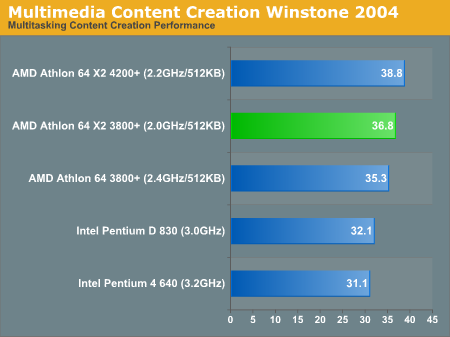
ICC SYSMark 2004
The first category that we will deal with is 3D Content Creation. The tests that make up this benchmark are described below:"The user renders a 3D model to a bitmap using 3ds max 5.1, while preparing web pages in Dreamweaver MX. Then the user renders a 3D animation in a vector graphics format."
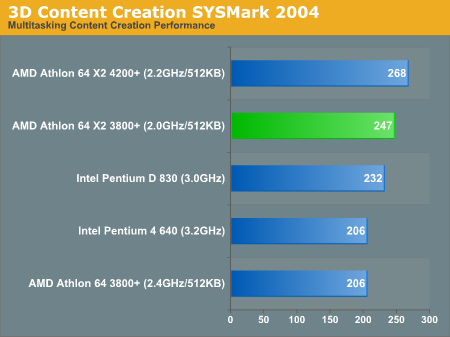
"The user uses Premiere 6.5 to create a movie from several raw input movie cuts and sound cuts and starts exporting it. While waiting on this operation, the user imports the rendered image into Photoshop 7.01, modifies it and saves the results. Once the movie is assembled, the user edits it and creates special effects using After Effects 5.5."
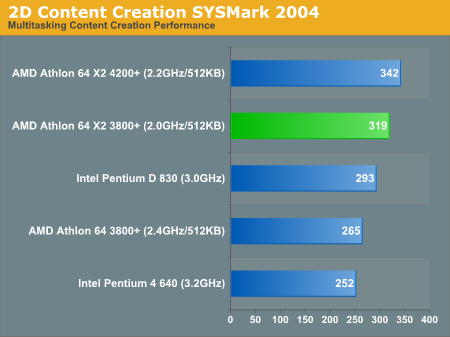
"The user extracts content from an archive using WinZip 8.1. Meanwhile, he uses Flash MX to open the exported 3D vector graphics file. He modifies it by including other pictures and optimizes it for faster animation. The final movie with the special effects is then compressed using Windows Media Encoder 9 series in a format that can be broadcast over broadband Internet. The web site is given the final touches in Dreamweaver MX and the system is scanned by VirusScan 7.0."
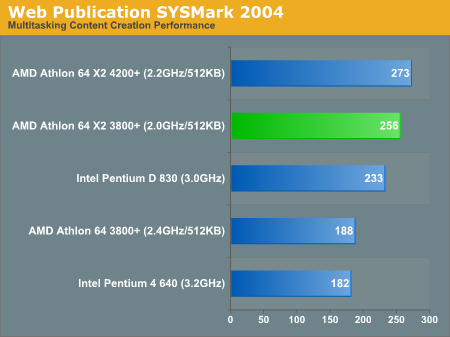
Mozilla + Media Encoder
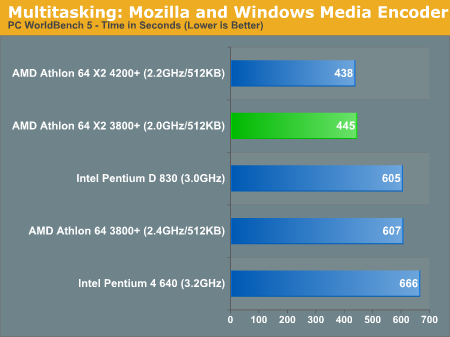










109 Comments
View All Comments
Houdani - Monday, August 1, 2005 - link
By that same logic, should Intel cut prices on the Pentium D 830, 840, and EE down to the same price as the Pentium D 820? Of course not, because with higher performance comes higher prices.Sure, AMD could release a 1.8GHz X2 3400+ at a $250 price point to cross with the Pentium D 820, but before that happens they'll continue to make a profit with what they've got before introducing a new chip which has been artificially gimped in order to meet the needs of the low end/entry market.
still - Monday, August 1, 2005 - link
Except that by the time you get a new motherboard that supports that cheaper Intel chip and the pricier DDR2 memory, any price advantage Intel had is already gone. And the AMD system still outperforms the Intel one 15% in for the 830D and 20% in the 820D. So choose wisely...SDA - Monday, August 1, 2005 - link
You know what's funny? Most of the customers I've had were more than happy to pay extra to have a PC that ran very quiet and cool. All of them said they'd like that, actually, but most of them added that they wouldn't mind a hefty premium. So do you think these customers would bite if I told them that $100 would buy them a faster, more capable, and cooler-running processor?Oh, it's expensive, to be sure. But saying that no one will ever want it just because you don't is, well, stupid.
fishbits - Monday, August 1, 2005 - link
"one major flaw in AMD's execution: price""AMD's Athlon 64 X2 was the better overall performer, just at the very wrong price point."
Anand, I wish you and the rest would seriously sit down and think about all the sniping and whining you've done lately about the prices of high(er)-end products. How, exactly, was AMD's price execution flawed? They can only make so many of the X2 chips, and they have been flying off the shelves at and above their suggested price. It's not like AMD's "flaw" was pricing them so high no one was buying them and they were gathering cobwebs in warehouses. What's "wrong" about this price point?
Let's look at it this way, is AnandTech "flawed" and "wrong" in its advertising pricing? I mean you could sell front-page add space for $5 per month. Or do you charge a reasonable price that keeps ads to a reasonable (non-overwhelming) number of ads on a page, without pricing so high that there's huge droughts of no ad revenue?
I couldn't care less if you were to deem products "too high to recommend to most users for their budgets and needs" and the such. But it's pretty petty that you and the crew constantly take slaps at products and their manufacturers because they're priced higher than we'd WISH they'd be, but still selling quite well and making those who can afford them quite happy. A new Corvette costs more than a Neon. This isn't "flawed" or "wrong." It's just another factor to take into consideration when purchasing and recommending. Now if something is seriously overpriced for its ability, by all means point it out. But stop coming across like you have no clue that the prices for higher-end parts ramp up quite steeply, and deservedly and understandably so. Been this way for decades and will continue to be this way for decades to come.
masher - Monday, August 1, 2005 - link
From AMD's perspective, there may be nothing "wrong" with pricing X2 chips far higher than two equivalent single CPUS...but from the consumer's persective, such a price point is most certainly flawed.So are you a consumer or an AMD stockholder? It should be obvious that-- for the average consumer-- a second core priced far above the first is a poor purchasing decision, and that such pricing will never lead to significant market penetration.
fishbits - Monday, August 1, 2005 - link
But that's just it, AnandTech is taking the stance that it is wrong from AMD's perspective, not from the consumer's. That is where I think they've gone off track. As far as a second core being priced far above the first, color me unfazed. If somehow AMD or Intel were able to bump single-core clock speed by 50%, would any of us be suprised that the new chip would cost (gasp!) AT LEAST double the price? On a dollars-per-Mhz scale, of course it's a loser. On a "getting my hands on a high-end performer" scale, it's easily a winner at double the price. Look at how much more we pay for just a 20% bump in single-core clock speed, and yet it doesn't generate the kind of whining that adding a whole second core and cache does."...Such pricing will never lead to significant market penetration".
Funny, last I heard X2s were selling very well, especially when measured against AMD's ability to produce them. As always, when production ramps up the cost will go down.
The other thing I'd add is that it's my understanding that the 820, a very good performer for its price, is that it's a subsidized chip. I gather (though could be wrong) that Intel sells them for zero profit, or even loses money on them to bump up market share. If that's the case, then its pricing is somewhat an exception and that should be provided as appropriate context in any comparison as Intel has the size and cash to do this, where AMD doesn't.
masher - Monday, August 1, 2005 - link
> "But that's just it, AnandTech is taking the stance that it is wrong from AMD's perspective..."I think you're reading your own bias into his statements.
> "Funny, last I heard X2s were selling very well, especially when measured against AMD's ability to produce them..."
Actually, they are selling well ONLY when measured against AMD's ability to produce them. An ability which is nearly-nonexistent. A few thousand cpus a month may sound like a lot to you, but it doesn't even pay for lunches at the corporate HQ, much less fund a few new multibillion dollar fabs.
AMD's trickle of high-priced X@ sales was useful for bootstrapping future sales...but for gaining any significant market share-- or even paying off a portion of the X2 R&D costs-- it was a nonentity. As I said before.
dougSF30 - Monday, August 1, 2005 - link
<i>but from the consumer's persective, such a price point is most certainly flawed. </i>Not so, because the infrastructure cost for a dual-socket equivalent is significantly higher.
masher - Monday, August 1, 2005 - link
But the comparison isn't between an Athlon and a dual-socket Opteron setup...but between AMD and Intel dual-cores. The "flaw" is charging $300-400 for a second core, when Intel will give you one for $100.Let's face it...while AMD trounces Intel in gaming and other single-threaded apps, performance is neck-to-neck for highly scalable apps...just the ones you'd want a dual-core processor in the first place. AMD can't afford to charge far more than Intel for these cores...not if they want to sell more than a few thousand cpus to the fanboi brigade. They have to bring their prices more in line. A step they've taken with the launch of the X2 3800.
mlittl3 - Monday, August 1, 2005 - link
Your power comparison graphs list both the manchester and toledo cores as having 512K cache. Is this a typo?